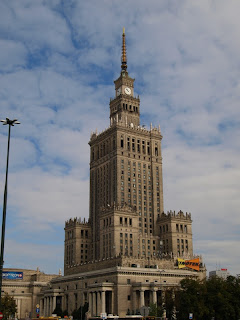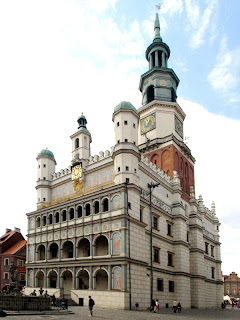We've been struggling to get a good WiFi signal on sites for the last week or so and this is the first time we have been able to update the blog.
As soon as we crossed the border into Latvia we remembered how dreadful the road surfaces are there. Fortunately we were taking a fairly short and direct route and soon found ourselves on the much better Lithuanian roads on our way to the capital – Vilnius.
As soon as we crossed the border into Latvia we remembered how dreadful the road surfaces are there. Fortunately we were taking a fairly short and direct route and soon found ourselves on the much better Lithuanian roads on our way to the capital – Vilnius.
Vilnius is
another city that suffered a great deal in WW2 and then endured years of Soviet
oppression. It is struggling to recover
but it is an uphill task. It is very
much a “lived-in” city with old apartment blocks cheek-by-jowl with countless
churches and expensive clothes shops.
We entered
what is left of the Old Town by the “Gates of Dawn” ...
 |
| Vilnius - Gates of Dawn and Chapel of the Blessed Mary |
... above which is a chapel dedicated to the Blessed Virgin Mary. She looks down serenely on the town from a painting which is reputed to have worked many healing miracles.
There has
been a flourishing Jewish quarter in the city for a very long time (it used to
be known as the Jerusalem of the North) and during WW2 it became two enclosed
ghettos housing over 40,000 people, mostly intellectuals, the sick and those
unable to work. Between 1941 and 1943
they were almost all marched 10 km out of the city to Paneriai and killed. The Gaon house of prayer, a famous library of
Strašūnas
and Synagogue buildings were then destroyed during the Soviet occupation. The place is marked by a bust of an 18th
century Jewish sage who could recite the entire Talmud (Jewish Law) by the age
of six.
Not far away
is the old Soviet KGB building which previously housed the German Gestapo. It is now the Museum of Genocide Victims and
the names of many of the Lithuanian people who were tortured and killed there
are inscribed on the walls.
Churches
varied from the almost grotesquely ornate to the beautifully simple in
style. The Cathedral’s Classical design
is rather unusual ...
... and in a
side chapel dedicated to St Casimir, Patron Saint of Vilnius, there were
several interesting sculptures including this one ...
... while
outside a statue of the 24th century Grand Duke Gediminus, legendary
founder of the city, stands guard.
A few
kilometres from Vilnius, is the lovely little town of Trakai, now a very
popular tourist destination. The only
real attraction, apart from the lakes that surround the town on three sides, is
the fairytale, 15th century, island castle. We still can’t get used to medieval castles
being built from brick!
We stayed on
a site right by the lake, equipped with an interesting sauna. (This area is
very popular with the Finns so many of the campsites has saunas)
Then we were
off back into Poland. Here are some of
the best main roads and motorways we have ever found in our travels but also
some of the worst, pot-holed, rutted roads anywhere. In Warsaw we stayed at a somewhat run-down
city campsite from which we were able to cycle into the city centre where one
of the first buildings we saw is known locally as “Stalin’s Wedding Cake” – the
Palace of Culture and Science - it was a “gift” from Stalin to the Polish
people.
The clock
was installed in 2000 and for two years it was the highest clock tower in the
world. For many it remains a lasting
symbol of the years of Soviet oppression.
Little of
the Old Town survived WW2 but some of it has been carefully restored.
In the
centre of the Old Town Square is one of many statues of a mermaid holding a
sword – a popular symbol of Warsaw. There
is a legend that she was captured by a wicked showman who thought people would
pay to see her. She was rescued by a
young man and promised to return to defend the people of Warsaw whenever they
were in trouble.
Palaces have
been restored ...
... and the
town walls rebuilt.
The Polish
people are deeply religious so the number and variety of churches came as no
surprise. The magnificent ceiling in St
Ann’s Church was especially spectacular:
A poignant
reminder of Nazi cruelty is a memorial to Dr Henryk Goldszmidt, a doctor,
author, teacher and child-care specialist who was sent to the death camp at
Treblinka and died there in 1942 with the children in his care.
Another
remarkable memorial is to the Warsaw Uprising in 1944
With the
Russian Army having reached the outskirts of Warsaw the Polish Government in
Exile in London ordered the Home Army in Warsaw to rise against the
Germans. They expected the Russian Army
to support them but they did not do so.
After a valiant but unequal struggle against massive German forces the
Home Army were forced to surrender on 2nd October 1944. During the fighting about 40,000 Polish
soldiers and 180,000 civilians died or were wounded.
Two of
Warsaw’s most famous inhabitants were Marie Curie who discovered the
radioactive elements Radium and Polonium.
Although she spent most of her life in Paris she was born in this house
...
... and the
composer Frederic Chopin whose memorial is in Łazienki Park.
Although
Chopin also lived much of his life and died and was buried in Paris it was his
wish that his heart be buried in free Poland.
His wish was carried out and his heart is buried in the Holy Cross
Church here in Warsaw.
If we were
disappointed by Vilnius, Warsaw exceeded our expectations. In spite of the ever presence of police and
security guards and the constant sound of police and ambulance sirens, there is
a pleasantly relaxed atmosphere. For
most people here life is not yet easy but hopes are high and things do seem to
be improving.
Poznan – We were told that Poznan was a
very beautiful city. There are certainly
plenty of interesting sculptures, churches and other old buildings with the Old
Market Square at their heart.
The Old
Market Square, surrounded by old merchants' houses, is a very lively place with street cafés and live entertainment. Its most impressive building is the Old Town
Hall ...
... inside
which is an amazing vaulted ceiling ...
... and an
interesting display of paintings, photographs and artefacts giving glimpses of
life in the city in days gone by. What
do you suppose this is? (The answer is
at the end of the blog.)
There are
also some ugly new buildings along with some well designed ones that fit into
their surroundings without pretending to be something they are not. The new Fire Station is one example,
reflecting the lines of the old town walls of which very little remains.
Here, as
throughout our travels, we found monuments to those who gave their lives in the
struggle for political freedom. This
monument is to those who died in demonstrations, starting in 1956, against the
Communist rule.
On the banks
of the river we found this ...
... and weren’t
sure if it is a modern sculpture or a regular meeting place for some of the
city’s homeless people!
The old
Citadel is now a public park obviously loved and well used by the local
people. A Sunday afternoon stroll there
found us face-to-face with German tanks – not another invasion but an open air
military museum!
There were
many other vehicles, aircraft and even some Russian rockets to be seen.
There are
also many sculptures in the park. One of
the strangest is this one of 112 walking figures by Magdalena Abakanowicz.
And we
caught a glimpse of the local wild-life.
Poznan
marked the end of our tour of the Baltic States and Poland. It has been a fascinating journey and we have
learnt a lot about the people, their history and culture as well as seeing lots
of beautiful (and some ugly) sights.
What did we
enjoy most? The glorious weather, empty
roads, lovely little villages with wooden houses, interesting architecture in
some of the towns, the vast range of delicious smoked fish and meats and the variety of different breads especially
in Estonia.
What will we
not miss? The dreadful road surfaces in
Latvia and Poland, the uncertainty of what the speed limit was in certain
places and most of all, the mosquitoes!!
We are
returning now to the UK to catch up with family and friends and to get the van
serviced, MOT tested etc. After
Christmas we will be off again on another adventure but we have not yet decided
where to go, so look out for a blog update in January.
We hope you
all have a wonderful, happy and peaceful Chistmas.
The item from the display in the Old Town
Hall is an early key-less typewriter.




















































